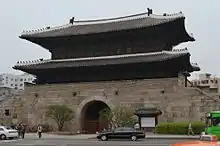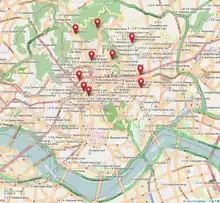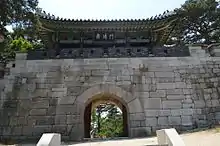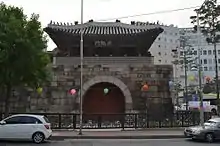The Eight Gates of Seoul
The Eight Gates of Seoul are a series of historic gates located in Seoul, South Korea. Two of the gates are now destroyed, although the others are still standing. The gates were constructed between 1396 and 1398, and allowed access to the city, which was surrounded by the Fortress Wall during the Joseon period.

Introduction

The Eight Gates were based roughly in the four cardinal and four intermediate directions of the compass. Of the eight gates, the North, South, East, and West were known as the “Four Great Gates” (사대문), while the Northwest, Northeast, Southeast, and Southwest gates were known as the “Four Small Gates” (사소문).
Of the eight gates, two (West and Southwest) no longer exist. Memorials are currently placed roughly where the West and Southwest gates once stood (July 2012). There has been discussion and announcements about rebuilding the West Gate,[1] but no construction has yet been undertaken (as of July 2012) for this gate.
On February 10, 2008, the South Gate was severely damaged in a fire set by an arsonist. The gate was rebuilt over five years, and reopened to the public on May 4, 2013.[2] This gate has the designation of National Treasure No. 1 of South Korea. Of the eight gates, the South and East gates are the largest, and both are located in busy market areas (Namdaemun Market and Dongdaemun Market, respectively).
Names
The eight gates have had various names over the centuries, and may still be referenced by different names. The charts below give the most common names for the gates. Official names and spellings are taken from signage currently found at and on the gates themselves. Note that Hanja is read right-to-left at times, and left-to right at other times. Thus, the character for "gate" (mun, 門) may appear either on the left or right side of actual signboards.
The Four Great Gates
| signboard |  |  |  | ||
| North Gate | East Gate | South Gate | West Gate | ||
| Official names | Romanization | Sukjeongmun | Heunginjimun | Sungnyemun | Donuimun |
| Korean Hangul | 숙정문 | 흥인지문 | 숭례문 | 돈의문 | |
| Sino-Korean Hanja | 肅靖門 | 興仁之門 | 崇禮門 | 敦義門 | |
| literal translation[3] | Rule Solemnly Gate | Rising Benevolence Gate | Exalted Ceremonies Gate | Loyalty Gate | |
| directional names | Romanization | Bukdaemun | Dongdaemun | Namdaemun | Seodaemun |
| Korean Hangul | 북대문 | 동대문 | 남대문 | 서대문 | |
| Sino-Korean Hanja | 北大門 | 東大門 | 南大門 | 西大門 | |
| literal meaning | “north big gate” | “east big gate” | “south big gate” | “west big gate” | |
| other names | Originally called Sukcheongmun. | Originally called Heunginmun (slightly different from present name). | |||
| notes | - Originally built in 1396.[4]
- Gatehouse later burned down; current gatehouse dates from 1976. | - Originally built 1398. Present construction dates from 1869.[5] | - Originally built in 1398.
- Heavily damaged by fire in 2008. Reopened in May 2013. | - Originally built 1396.
- No longer exists. Torn down in 1915 during the Japanese colonial period.[1] Plans to rebuild exist, and is presumed to start in 2022. |
The Four Small Gates
| signboard |  |  |  | ||
| Northwest Gate | Northeast Gate | Southeast Gate | Southwest Gate | ||
| official names | Romanization | Changuimun | Hyehwamun | Gwanghuimun | Souimun |
| Korean Hangul | 창의문 | 혜화문 | 광희문 | 소의문 | |
| Sino-Korean Hanja | 彰義門 | 惠化門 | 光熙門 | 昭義門 | |
| literal translation[6] | Showing the Correct Thing Gate | Distribution of Wisdom Gate | Bright Light Gate | Promotion of Justice Gate | |
| directional names | Romanization | Buksomun | Dongsomun | Namsomun | Seosomun |
| Korean Hangul | 북소문 | 동소문 | 남소문 | 서소문 | |
| Sino-Korean Hanja | 北小門 | 東小門 | 南小門 | 西小門 | |
| literal meaning | "north small gate" | "east small gate" | "south small gate" | "west small gate" | |
| other names | Jahamun.[7] | Originally called Honghwamun.[8] | Originally called Sugumun ("Water Channel Gate") | Originally called Sodeokmun. | |
| notes | - Originally built in 1396.
- Gatehouse was burned down in 1592, and rebuilt in 1740-1741. The gate currently has the oldest gatehouse of the small gates. | - Originally built in 1396.
- Destroyed during the Japanese colonial period, but restored in 1992. | - Originally built in 1396.
- Rebuilt 1711-1719. Largely destroyed during the Korean War, but restored in 1976.[9] | - Originally built in 1396.
- No longer exists. Torn down in 1914 during the Japanese colonial period. |
Images
| gate | front view | other view |
| Northwest Gate |  Changuimun Gate, Seoul, Korea |  Changuimun Gate, rear view, Seoul, Korea |
| North Gate |  Sukjeongmun Gate, Seoul, Korea |  Sukjeongmun Gate, rear view, Seoul, Korea |
| Northeast Gate |  Hyehwamun Gate, Seoul, Korea |  Hyehwamun Gate, detail, Seoul, Korea |
| East Gate |  Heunginjimun Gate, Seoul, Korea |  Heunginjimun Gate, side view, Seoul, Korea |
| Southeast Gate |  Gwanghuimun Gate, Seoul, Korea |  Gwanghuimun Gate, with Fortress Wall, Seoul, Korea |
| South Gate |  Sungnyemun Gate, Seoul, Korea. Front of gate, photographed April, 2013 |  Sungnyemun Gate, Seoul, Korea. Rear of gate, photographed April, 2013 |
| Southwest Gate
Souimun (No longer exists) |  Souimun Gate historical image, Seoul, Korea |  Souimun Gate marker, Seoul, Korea |
| West Gate
Donuimun (No longer exists) |  Donuimun Gate, Seoul, Korea |  Donuimun Gate Memorial, Seoul, Korea |
See also
Notes
Citations
- "Seoul City to Restore Ancient West Gate". Chosun Ilbo.
- Hanano, Natasha (1 May 2013). "Sungnyemun: South Korean National [Treasure] Reopens After [Five] Year Restoration". Travelers Today. Retrieved 10 June 2013.
- "The Gates and Walls of Seoul". Ministry of Culture, Sports, and Tourism of the Republic of Korea.
- "Sukjeongmun Gate". Visit Korea.
- "Heunginjimun Gate". Exploring Korea. Archived from the original on 2012-06-11.
- "The Gates and Walls of Seoul". Ministry of Culture, Sports, and Tourism of the Republic of Korea.
- "Changuimun Gate (Jahamun Gate)". Visit Korea.
- "Hyehwamun Gate (Honghwamun Gate)". Visit Korea.
- "Gwanghuimun Gate". Exploring Korea. Archived from the original on 2012-06-11. Retrieved 2012-06-18.
References
- Heunginjimun: https://web.archive.org/web/20120611045420/http://www.exploringkorea.com/heunginjimun-gate/ Retrieved 2012.06-16.
- Sukjeongmun: Retrieved 2012-06-16.
- Sungnyemun (South gate): http://english.visitkorea.or.kr/enu/SI/SI_EN_3_1_1_1.jsp?cid=264257 Archived 2014-07-14 at the Wayback Machine Retrieved 2012-06-16.
- Changuimun: http://english.visitkorea.or.kr/enu/SI/SI_EN_3_1_1_1.jsp?cid=1035096 Archived 2013-11-11 at the Wayback Machine Retrieved 2012-06-16.
- Hyehwamun: http://english.visitkorea.or.kr/enu/SI/SI_EN_3_1_1_1.jsp?cid=1061567 Archived 2014-12-04 at the Wayback Machine Retrieved 2012-06-16.
- Gwanghuimun: https://web.archive.org/web/20120611045410/http://www.exploringkorea.com/gwanghuimun-gate/ Retrieved 2012-06-16.
- Donuimun: http://english.chosun.com/site/data/html_dir/2009/10/22/2009102200725.html Retrieved 2012-06-16.
- Translations: http://www.koreaaward.com/kor/index.php?mid=news_today&document_srl=5616%5B%5D Retrieved 2012.06.16.